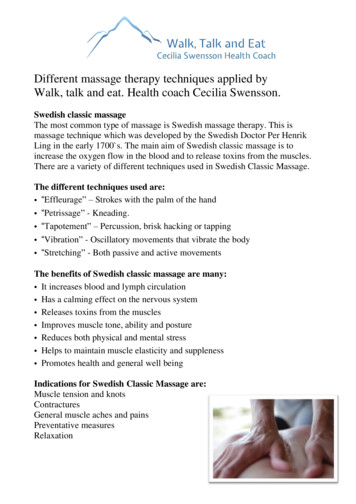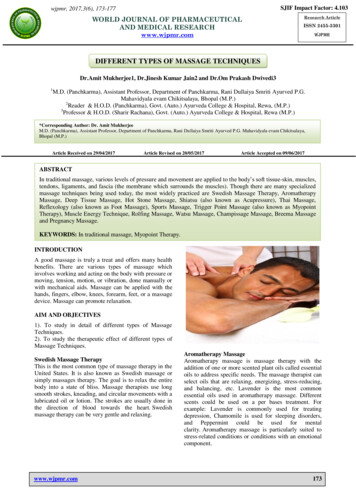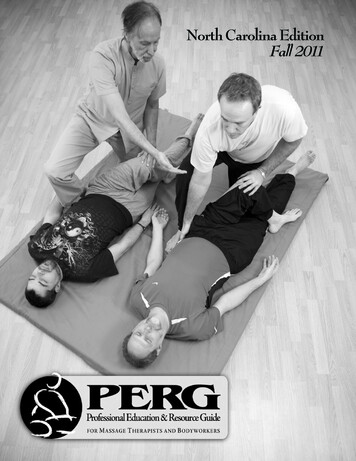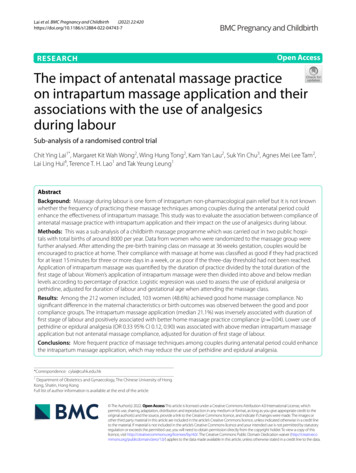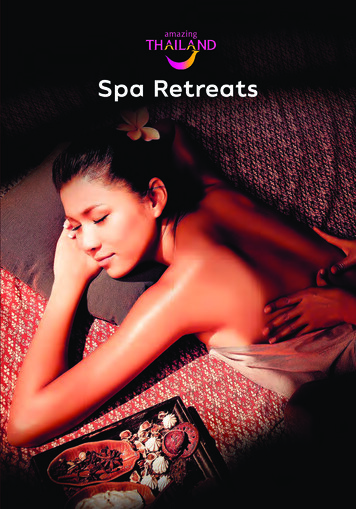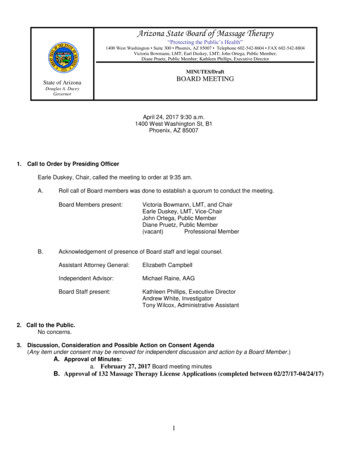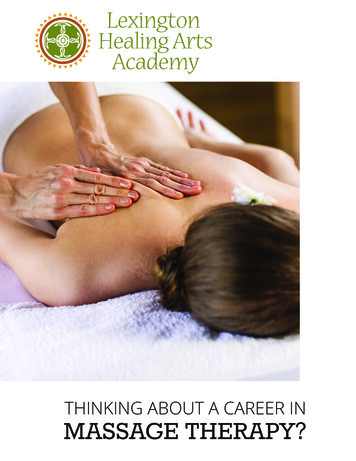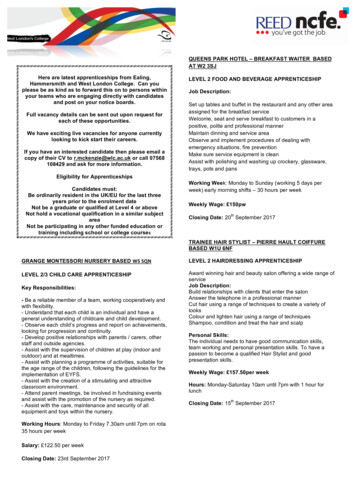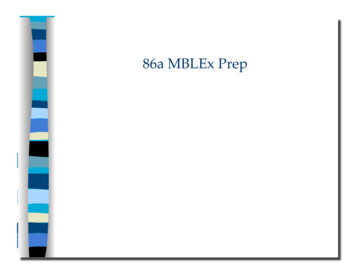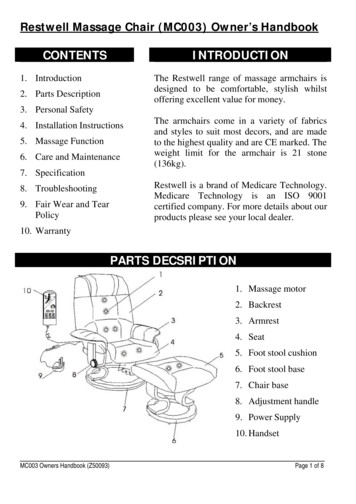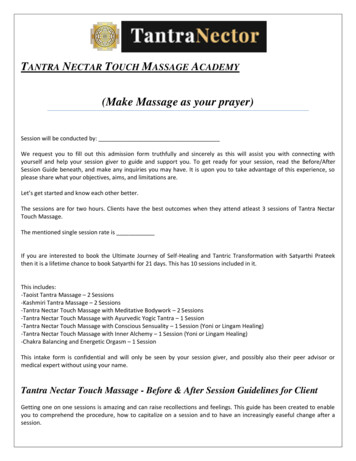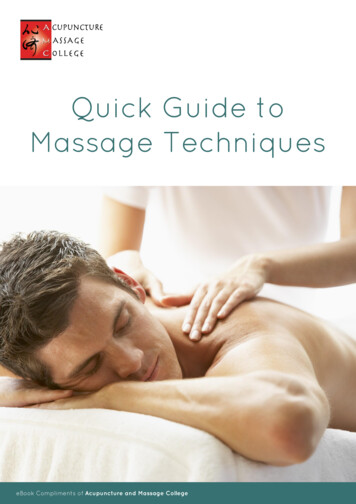
Transcription
Quick Guide toMassage TechniqueseBook Compliments of Acupuncture and Massage College
Quick Guide to Massage TechniquesMassage therapy is a popular way to promote wellness and treat healthproblems. But what we mean when we say “massage” varies widely fromtechnique to technique. In some cases, there are more differences thanthere are similarities.Whether you’re choosing from different massage techniques as a client, orconsidering becoming a massage therapist, it’s important to know thedifferences. Here’s a general overview of the major massage techniquesused for wellness:eBook Compliments of Acupuncture and Massage College2
Quick Guide to Massage Techniques1. Traditional Chinese MassageTraditional Chinese massage employs the ancient Chinese system of manual therapywith a wide range of techniques. Moves may be light and soothing, or strong andinvigorating. Every touch involves restoring balance and regulating the flow of energythroughout the body. It’s a good fit if you’ve got – or want to develop – a holisticmindset.Similar techniques include:Shiatsu. Shiatsu is a form of bodywork originated in Japan and is based on thetheoretical framework of Chinese medicine. Shiatsu means "finger pressure". Shiatsutechniques include massage with fingers, thumbs, feet and palms; assisted stretching,joint manipulation and mobilization. One of the fundamental concepts ofChinese/Japanese medicine is Qi (pronounced "chee"). Shiatsu, like acupuncture,stimulates the body’s vital energy, Qi. In a Shiatsu session the therapist accesses the Qithrough points along the meridians called Vital Points. The Shiatsu therapist is trained torecognize patterns of disharmony and blockages in the body. The massage is performedthrough the clothing and has been described as needle-free acupuncture.Tuina. Tui Na (pronounced "twee-na”) is one of the most popular and oldest systems ofTraditional Chinese Medicine. Treatment helps with superficial trauma injury and a widevariety of musculoskeletal problems. Tui Na is often used when acupuncture is notappropriate. Many of the techniques are gliding (known as effleurage or Tui), kneading(petrissage or Nie), percussion (tapotement or Da), friction, pulling, rotation, rocking,vibration, and shaking. One of Tui Na’s advantages over simple massage is its ability tofocus on specific problems, especially chronic pain associated with the muscles, joints,and skeletal system.eBook Compliments of Acupuncture and Massage College3
Quick Guide to Massage Techniques2. Medical MassageMedical massage combines pathology and specific treatments to address disease, pain,and recovery. Medical massage is often offered in doctor’s offices or in physical therapysettings, where multiple health care providers come together to help people heal, feelbetter, and get stronger. It’s a good fit if you’ve got an inquisitive mind when it comes tomedicine, and like working with and being around others.Similar techniques include:Trigger Point Therapy. This is an integrated therapeutic massage that alleviatesdiscomfort. Pressure is applied directly to the “trigger point,” which is the tight area withinthe muscle tissue that is causing the pain. The recipient is actively involved in themassage, doing breathing exercises and verbalizing the location and severity of thepain.Rolfing. Rolfing massage is used to improve body alignment, posture, and functioning.Instead of focusing on specific areas of pain or tension, it is used to promote wellnessand balance throughout the body. By manipulating soft tissue and providing educationabout overall movement, it helps people use their muscles more efficiently and alleviatechronic strain patterns.eBook Compliments of Acupuncture and Massage College4
Quick Guide to Massage Techniques3. Swedish MassageSwedish massage is one of the most commonly taught and well-known massagetechniques. It involves using vigorous moves of kneading, rolling, vibration, and tappingto stimulate circulation. Swedish Massage helps people relax, dissolve scar tissue, speedhealing, and reduce swelling. It’s a good fit if you’re striving for more calm andrelaxation in your life.Similar techniques include:Reflexology. Reflexology can help reduce pain, increase relaxation, and stimulatecirculation. The technique involves manipulating specific reflex areas in the foot, hands,and ears that correspond to other parts of the body to regulate the flow of energy andrelieve areas of congestion. It stimulates self-healing and promotes overall balance.Hot Stone. In this technique, water-heated stones are placed at key points of the bodyto relax muscles and allow the therapist to reach deeper muscle layers. The hot stonesalso expand blood vessels, which improves circulation. Hot stone massage can alsorelieve chronic pain, alleviate stress, and promote deep relaxation.4. Sports MassageBefore sports events, sports massage helps athletes stimulate blood flow and warm upmuscles. After events, the technique can calm the nervous system and flush toxins fromthe body. If injuries happen, sports massage hastens healing and helps people returnsooner to activities. Sports medicine is a good fit for those who like activity and beingon-the-go.Similar techniques include:Deep Tissue. Like its name suggests, deep tissue massage involves applying pressure toreach the deepest layers of muscle tissue, tendons, and fascia. It is used to relievechronic muscular pain, promote injury rehabilitation, and reduce inflammation. Thetechnique requires a thorough understanding of anatomy and physiology andadvanced training.Neuromuscular. This technique is based on the laws of neurology and how the centralnervous system controls pain. It uses soft-tissue manipulation to balance the nervoussystem with the musculoskeletal system to address the root causes of pain, releasespasms, repair injured tissues, and improve blood flow and posture.eBook Compliments of Acupuncture and Massage College5
Quick Guide to Massage TechniquesAre you on a quest for knowledge when itcomes to massage?If you’re hungry for knowledge about all of the different types of massagetherapy, you may find that being a massage therapist is a good fit for you.Nationally accredited Acupuncture and Massage College offers several massagetherapy degree programs in Traditional Chinese Massage, Swedish Massage, MedicalMassage, and Sports Massage. Each program can be completed in less than a yearand provides the knowledge and experience to apply for state licensure and begin anexciting new career as a massage therapist. Learn more about the AM Collegemassage therapy program on our website, or click below for a free ebook.eBook Compliments of Acupuncture and Massage College6
Quick Guide to Massage Techniques 3. Swedish Massage Swedish massage is one of the most commonly taught and well-known massage techniques. It involves using vigorous moves of kneading, rolling, vibration, and tapping to stimulate circulation. Swedish Massage helps people relax, dissolve scar tissue, speed healing, and reduce swelling.
